army air force
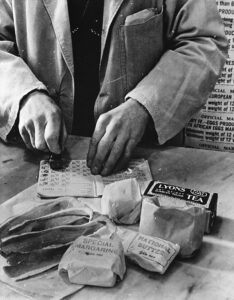
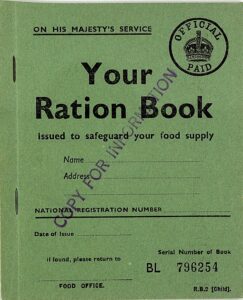 When my dad, Staff Sergeant Allen Spencer, was serving in the Army Air Force during World War II, rationing was not an unusual thing. Nevertheless, most of us think of rationing to be in the form of gas rationing. That is pretty much the kind of rationing we have heard being used these days, but on January 8, 1941, the government of the United Kingdom began a different kind of rationing…food. I can see the value of such a thing, because by limiting the amount of food each person could have, they could ensure that everyone was able to get enough food to sustain them. People weren’t going to gain weight on the amount of food allowed, but they could survive. I suppose the fact that there were so many extra people, in the form of the military forces, just added to the need to ration.
When my dad, Staff Sergeant Allen Spencer, was serving in the Army Air Force during World War II, rationing was not an unusual thing. Nevertheless, most of us think of rationing to be in the form of gas rationing. That is pretty much the kind of rationing we have heard being used these days, but on January 8, 1941, the government of the United Kingdom began a different kind of rationing…food. I can see the value of such a thing, because by limiting the amount of food each person could have, they could ensure that everyone was able to get enough food to sustain them. People weren’t going to gain weight on the amount of food allowed, but they could survive. I suppose the fact that there were so many extra people, in the form of the military forces, just added to the need to ration.
Of course, some food rationing occurred before this date too. Rationing was introduced temporarily by the government of the United Kingdom several times during the 20th century, during and immediately after a war. At the start of World War II in 1939, the United Kingdom was importing 20 million long tons of food per year, including about 70% of its cheese and sugar, almost 80% of its fruit and about 70% of its cereals and fats. It also imported more than half of its meat and relied on imported feed to support its domestic meat production. The civilian population of the country alone, was about 50 million. It was one of the principal strategies of the Germans in the Battle of the Atlantic to attack shipping bound for Britain, restricting British industry and  potentially starving nations into submission. Siege tactics were not unusual and have been used throughout history by several countries.
potentially starving nations into submission. Siege tactics were not unusual and have been used throughout history by several countries.
So, to deal with the various forms of shortages, and sometimes extreme shortages, the Ministry of Food instituted a system of rationing. Basically, the Ministry of Food would buy most rationed items, forcing anyone who wanted some of these items to register at chosen shops. Upon registration, they were provided with a ration book containing coupons. The shopkeeper was provided with enough food for registered customers. Purchasers had to present ration books when shopping so that the coupon or coupons could be cancelled as these pertained to rationed items. Rationed items had to be purchased and paid for as usual, although their price was strictly controlled by the government and many essential foodstuffs were subsidized. Basically, rationing restricted what items and what amount could be purchased, as well as what they would cost. To make matters worse the items that were not rationed could be scarce, because the Ministry of Food did not purchase said items. The priced for some of the unrationed items were also controlled by the Ministry of Food, and for many people those prices were too high for them to be able to afford, causing people to try to cheat the system, and merchants to try to either assist the people or to gouge the public in order to make a buck. This brought penalties for 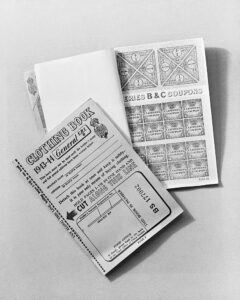
 breaking the laws of rationing.
breaking the laws of rationing.
During the World War II, rationing was not restricted to food, and was part of a strategy including controlled prices, subsidies, and government-enforced standards. The goal for this controlled pricing and rationing was to manage scarcity and prioritize the armed forces and essential services with the supplies they needed first. They did still try to make available to everyone, an adequate and affordable supply of goods of acceptable quality. I suppose that how well they accomplished their goal, would be a matter of opinion. Of course, like all wars, World War II ended, as did the rationing of the time, but rationing has returned a number of times, and will again, should the need arise.
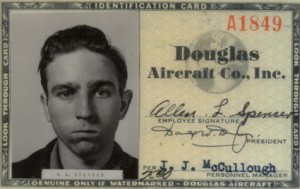 My dad, Allen Spencer, went to work for Douglas Aircraft Company on May 19, 1942. He was a young man of just 18 years. Dad wasn’t with Douglas Aircraft Company for very long, because of World War II, and his enlistment in the Army Air Force on March 12, 1943. Nevertheless, the job my dad had while he was at Douglas Aircraft Company would play a big part in his future military assignment as a flight engineer on a B-17 Bomber during World War II, stationed at RAF Great Ashfield in Suffolk, England. Because of Dad’s job there, I have always had an interest in Douglas Aircraft Company.
My dad, Allen Spencer, went to work for Douglas Aircraft Company on May 19, 1942. He was a young man of just 18 years. Dad wasn’t with Douglas Aircraft Company for very long, because of World War II, and his enlistment in the Army Air Force on March 12, 1943. Nevertheless, the job my dad had while he was at Douglas Aircraft Company would play a big part in his future military assignment as a flight engineer on a B-17 Bomber during World War II, stationed at RAF Great Ashfield in Suffolk, England. Because of Dad’s job there, I have always had an interest in Douglas Aircraft Company.
While people might think they don’t know much about Douglas Aircraft Company, they really do, just under a different name. The Douglas Aircraft Company was an American aerospace manufacturer based in Southern California. It was founded in 1921 by Donald Wills Douglas Sr and later merged with McDonnell Aircraft in 1967 to form McDonnell Douglas. With that merger, Douglas Aircraft Company ceased to exist. The name McDonnell Douglas might be a bit more familiar to people, but it was really when McDonnell Douglas merged with Boeing in 1997 that the company became a household name. Everyone has heard of Boeing Aircraft Company.
While Douglas Aircraft Company no longer exists, they made great strides in the aerospace industry during their time in business. One early claim to fame was the first circumnavigation of the world by air in Douglas airplanes in 1924. That was just 21 years after the first powered flight, taken by the Wright Brothers. That may sound like a long time, but to go from the rickety-looking plane the Wright Brothers flew, to something that was  capable of making the flight around the world in just 21 years is truly outstanding. The circumnavigation mission was first presented to Douglas Aircraft Company in 1923, when the US Army Air Service, interested in carrying out a mission to circumnavigate the Earth for the first time by aircraft, approached Douglas Aircraft Company to present it to them. The mission was called “World Flight.” Donald Douglas proposed a modified Douglas DT to meet the Army’s needs. The two-place, open cockpit DT biplane torpedo bomber had previously been produced for the US Navy. The DTs were taken from the assembly lines at the company’s manufacturing plants in Rock Island, Illinois, and Dayton, Ohio, to be modified.
capable of making the flight around the world in just 21 years is truly outstanding. The circumnavigation mission was first presented to Douglas Aircraft Company in 1923, when the US Army Air Service, interested in carrying out a mission to circumnavigate the Earth for the first time by aircraft, approached Douglas Aircraft Company to present it to them. The mission was called “World Flight.” Donald Douglas proposed a modified Douglas DT to meet the Army’s needs. The two-place, open cockpit DT biplane torpedo bomber had previously been produced for the US Navy. The DTs were taken from the assembly lines at the company’s manufacturing plants in Rock Island, Illinois, and Dayton, Ohio, to be modified.
Four of these modified aircraft left Seattle, Washington, on April 6, 1924, flying west, and two of these returned there on September 28 to great fanfare. Unfortunately, one plane had been lost under fog conditions, and another was forced down over the Atlantic and sank. The DWC prototype was then rechristened and joined the other two in completing the North American leg of the flight. With the success of this flight, the Army Air Service ordered six similar aircraft as observation aircraft.
In 1934, Douglas produced a commercial twin-engined transport plane, the Douglas DC-2, which was followed by the famous DC-3 in 1936. The wide range of aircraft produced by Douglas included airliners, light and medium bombers, fighter aircraft, transports, reconnaissance aircraft, and experimental aircraft. While these were all important types of aircraft, it would really be the work they did during World War II, that really put 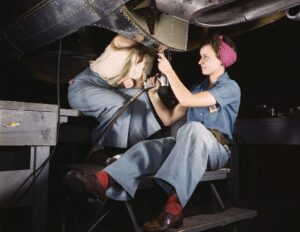 them on the map in my opinion. With so many young men heading off to war, the women really stepped up at this time and built many of the World War II planes. During that time, Douglas joined the BVD (Boeing-Vega-Douglas) consortium to produce the B-17 Flying Fortress. As far as I’m concerned, that was one of the greatest planes every produced. I suppose that sounds odd, considering that it was so long ago, but for its time, the B-17 was and really still is legendary. And while I don’t know if my dad had a part in building the B-17 Bomber, I know that he repaired them and knew them inside and out. I am proud of the work my dad did on the airplanes he helped to build, and proud of his time with Douglas Aircraft Company.
them on the map in my opinion. With so many young men heading off to war, the women really stepped up at this time and built many of the World War II planes. During that time, Douglas joined the BVD (Boeing-Vega-Douglas) consortium to produce the B-17 Flying Fortress. As far as I’m concerned, that was one of the greatest planes every produced. I suppose that sounds odd, considering that it was so long ago, but for its time, the B-17 was and really still is legendary. And while I don’t know if my dad had a part in building the B-17 Bomber, I know that he repaired them and knew them inside and out. I am proud of the work my dad did on the airplanes he helped to build, and proud of his time with Douglas Aircraft Company.

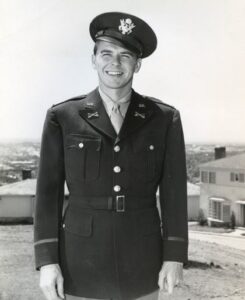 It’s almost unheard of to have a cavalry officer suddenly completely move in a different direction, and become an Army Air Force officer, but on May 15, 1942, Lieutenant Ronald Reagan, who had enlisted in the Army in 1935, was a cavalry officer at the time, applied for reassignment to the Army Air Force. Switching from the Army to the Army Air Force, while not unheard of, was an unusual event, especially in that no one really expected to be in the service for an extended period of time. For the most part, during World War II, it had been agreed upon that the soldier would be returned to the United States by February 1946. That said, it didn’t always make sense to make such a big move as switching branches of service.
It’s almost unheard of to have a cavalry officer suddenly completely move in a different direction, and become an Army Air Force officer, but on May 15, 1942, Lieutenant Ronald Reagan, who had enlisted in the Army in 1935, was a cavalry officer at the time, applied for reassignment to the Army Air Force. Switching from the Army to the Army Air Force, while not unheard of, was an unusual event, especially in that no one really expected to be in the service for an extended period of time. For the most part, during World War II, it had been agreed upon that the soldier would be returned to the United States by February 1946. That said, it didn’t always make sense to make such a big move as switching branches of service.
Then Lieutenant Ronald Reagan was, at least at that time, mostly looking to have a career in acting, and it was here that he would eventually put his thespian background to use making World War II propaganda films. Once his transfer was approved on June 9, 1942, Reagan was given a job as a public relations officer for the First Motion Picture Unit. The First Motion Picture Unit (FMPU) produced military training, morale, and propaganda films to aid the war effort. FMPU released Frank Capra’s “Why We Fight” series and a documentary of the bomber Memphis Belle, the crew of which completed a standard-setting 25 bombing missions in Europe for the first time. No other plane and crew, to that date, had managed to fly the 25 missions and make it back. War was a dangerous lifestyle for the Allied planes. The films were screened on domestic training grounds and in troop camps overseas as well as in movie theaters at home. The Memphis Belle documentary gave people hope that it could be done, and all was not lost.
Reagan did several other films, one of which, “Air Force,” which was later renamed “Beyond the Line of Duty.” That movie told the true story of the heroic feats of aviator Shorty Wheliss and his crew. Reagan narrated the film. While the documentary was originally intended simply to promote investment in war bonds, it won an 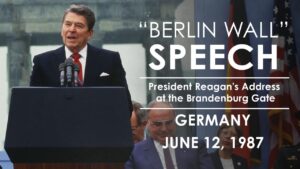
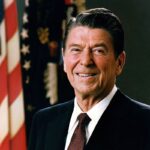 Academy Award in 1943 for best short subject. Reagan went on to narrate or star in three more shorts for FMPU including “For God and Country,” “Cadet Classification,” and “The Rear Gunner.” Reagan also appeared as Johnny Jones in the 1943 full-length musical film This is the Army. Of course, as we all know, Ronald Reagan’s true destiny was to become one of our greatest presidents of all time and a very brave man.
Academy Award in 1943 for best short subject. Reagan went on to narrate or star in three more shorts for FMPU including “For God and Country,” “Cadet Classification,” and “The Rear Gunner.” Reagan also appeared as Johnny Jones in the 1943 full-length musical film This is the Army. Of course, as we all know, Ronald Reagan’s true destiny was to become one of our greatest presidents of all time and a very brave man.
 Many people would agree that one of the greatest presidents the United States ever had was Ronald Reagan. He was not what we would consider a career politician, and in fact, most would knw him as an actor long before he was a politician. Nevertheless, after spending time as the President of the Screen Actors’ Guild, where he fought against Communist influence on the screen, Ronald Reagan was elected governor of California in 1966. He then became president in 1980, and the rest, as they say is history, but it is not the end.
Many people would agree that one of the greatest presidents the United States ever had was Ronald Reagan. He was not what we would consider a career politician, and in fact, most would knw him as an actor long before he was a politician. Nevertheless, after spending time as the President of the Screen Actors’ Guild, where he fought against Communist influence on the screen, Ronald Reagan was elected governor of California in 1966. He then became president in 1980, and the rest, as they say is history, but it is not the end.
Ronald Reagan would prove to be a very strong person in many areas of his life…some we know of, and some, maybe not…or at least, I didn’t. After college, where Reagan was an average student, and basically considered a “jack of all trades,” he did some work in radio and such until deciding to enlist in the Army Enlisted Reserve. He was commissioned a second lieutenant in the Officers’ Reserve Corps of the Cavalry on May 25, 1937. On April 18, 1942, Reagan was ordered to active duty, but because of poor eyesight, he was classified for limited service only, which excluded him from serving overseas. His first assignment was at the San Francisco Port of Embarkation at Fort Mason, California, as a liaison officer of the Port and Transportation Office. Upon the approval of the Army Air Forces (AAF), he applied for a transfer from the cavalry to the AAF on May 15, 1942, and was assigned to AAF Public Relations and subsequently to the First Motion Picture Unit (officially, the 18th AAF Base Unit) in Culver City, California. On January 14, 1943, he was promoted to first lieutenant and was sent to the Provisional Task Force Show Unit of “This Is The Army” at Burbank, California. He returned to the First Motion Picture Unit after completing this duty and was promoted to captain on July 22, 1943. While he did not serve in combat, President Reagan was shot. Most of us know that President Reagan survived an assassination attempt on March 30, 1981, when he and his press secretary James Brady were both shot. Also hit by gunfire from would-be assassin John Hinckley Jr outside the Washington Hilton Hotel, were Washington police officer Thomas Delahanty and Secret Service agent Tim McCarthy. President Reagan was “close to death” when he arrived at George Washington University Hospital. He was stabilized in the emergency room, then underwent emergency exploratory surgery. He recovered from his gunshot wound, and was released from the hospital on April 11, becoming the first serving US president to survive being shot in an assassination attempt. President Reagan became very popular after the attempt of his life, with the polls indicating his approval rating to be around 73 percent.
For his part, Reagan believed that God had spared his life so that he “might go on to fulfill a higher purpose.” That is true in my opinion, but it was not the first time Ronald Reagan’s life had been placed at risk. President Reagan attended Dixon High School, where he developed interests in acting, sports, and storytelling, but his first job involved working as a lifeguard at the Rock River in Lowell Park in 1927. He was a life guard there for six years, and during that time, Reagan performed 77 rescues. While much of the rest of his career was highly 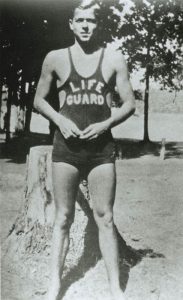 public, and well known by most people, this little tidbit was rather hidden in the archives of his life. I suppose many people thought that his job as a lifeguard was a minor role within the many roles he played in his lifetime, but I doubt if the 77 people whose lives he saved as a lifeguard would consider it to be such a minor role. If you have ever been saved from drowning…and I have…you know that you will never forget that person who saved you. I never knew my rescuer’s name, but to this day, I can see her face. I was a girl of about 10 or 12 maybe, and had no training in swimming, but I had achieved the great height of 5 feet, and thought that meant I could swim in the 5 foot area of the pool, not considering that 5 feet was at the top of my head. Thank God for the girl swimming by, who pushed me to the side of the pool. Needless to say, I taught myself to swim after that, and before summer’s end I had passed my swimming test at the pool. What President Reagan did for those 77 people, was as heroic as any soldier. A flailing victim in danger of drowning can take down their would be rescuer, and then both would likely drown. It takes a special person to put their life at risk to save another, and as in many other areas of his life, President Reagan was a true hero.
public, and well known by most people, this little tidbit was rather hidden in the archives of his life. I suppose many people thought that his job as a lifeguard was a minor role within the many roles he played in his lifetime, but I doubt if the 77 people whose lives he saved as a lifeguard would consider it to be such a minor role. If you have ever been saved from drowning…and I have…you know that you will never forget that person who saved you. I never knew my rescuer’s name, but to this day, I can see her face. I was a girl of about 10 or 12 maybe, and had no training in swimming, but I had achieved the great height of 5 feet, and thought that meant I could swim in the 5 foot area of the pool, not considering that 5 feet was at the top of my head. Thank God for the girl swimming by, who pushed me to the side of the pool. Needless to say, I taught myself to swim after that, and before summer’s end I had passed my swimming test at the pool. What President Reagan did for those 77 people, was as heroic as any soldier. A flailing victim in danger of drowning can take down their would be rescuer, and then both would likely drown. It takes a special person to put their life at risk to save another, and as in many other areas of his life, President Reagan was a true hero.
 The pilots of the war birds were brave men. They were tasked with staying the course while under heavy anti-aircraft fire and flak. That would be a major undertaking for most of us because in that situation, all our mind can think to do is to turn and run. These men had to stay in place so they could make the bomb runs, or protect those who were. Of course, there were gunners tasked with keeping the enemy planes at bay, but they couldn’t fly the plane to get you home.
The pilots of the war birds were brave men. They were tasked with staying the course while under heavy anti-aircraft fire and flak. That would be a major undertaking for most of us because in that situation, all our mind can think to do is to turn and run. These men had to stay in place so they could make the bomb runs, or protect those who were. Of course, there were gunners tasked with keeping the enemy planes at bay, but they couldn’t fly the plane to get you home.
United States Army Air Force Lieutenant William R Lawley Jr, was a pilot on a B-17 Bomber on February 20, 1944. It was the first day of “Big Week,” and Lieutenant Lawley’s Boeing B-17 Flying Fortress was at the head of a formation of one thousand bombers sent to bomb Germany’s production and aircraft manufacturing facilities. “Big Week” was the Allied plan to spend seven days ruthlessly dropping explosives onto enemy aircraft production facilities deep behind enemy lines. Day and night, wave after wave of American B-17 Flying Fortresses, B-24 Liberators, and British Lancasters blasted shipyards, railroad junctions, power plants, airfields, steel production facilities, dams, and military bases relentlessly, igniting everything from ball bearing plants to oil refineries up into towering explosive fireballs, to make it impossible for anyone in Germany to build a working fighter plane.
Suddenly, the call rang out, “Bandits, incoming, three o’clock high!” Immediately, the gunners began shooting to fight off the enemy planes, while Lawley held the plane steady. The loud, rumbling propellers roared as he pushed open the throttle and smashed through a thick black cloud of anti-aircraft smoke at nearly three hundred miles an hour, all while keeping in tight formation with hundreds of other B-17s. A pair of Nazi Focke-Wulf 190 fighter planes screamed by, ripping off thousands of rounds from twin-linked machine guns and heavy 20mm autocannons. Black puffs of enemy artillery popped up all around Lawley’s massive aircraft craft. The enemy fighters screamed past at speeds of over four hundred miles an hour. As the gray Nazi fighters dove down towards another squadron of American bombers below, Lawley’s starboard waist gunner zeroed in on them with his .50-caliber machine gun with a quick burst of tracer fire, but had to release the trigger as a pair of American P-47 Thunderbolt fighter planes dropped in to chase them. These Bomber raids were nothing new for Lawley. Born in Alabama, this 23 year old veteran pilot had already flown nine missions over Germany in the last year. This was his tenth mission, but the first at the controls of a brand-new B-17, nicknamed Cabin in the Sky III, because the first two Cabin in the Sky aircraft been blown up.
Suddenly, voices on the intercom called out enemy fighters, this time diving down from behind. With the sun at their backs, blinding the tail gunner, the Focke-Wulfs ignored the deadly clouds of flak ripping apart the sky around them and hurtled straight into the B-17 formation. Their 20mm cannons struck home at one of Lawley’s wingmen, catching her engines on fire and dropping her out of the sky like a brick. Another flak explosion hit even closer, rocking Cabin in the Sky III and peppering one of the engines with shards of metal, causing it to burst into flames. Lawley ordered the copilot to shut it down and kept moving. More calls came in. “Six o’clock low.” “Three o’clock level.” The Nazis were everywhere, attacking from seemingly every direction at once. The B-17s stuck close together, knowing that the only way to survive was to stay close and lay down heavy fields of  machine gun fire. As his gunners fired in every direction, Lawley looked through his cockpit window to see a fleet of twenty or so 190s drop down in front of him, pick out targets, and open fire. With a deafening crash, a 20mm high explosive autocannon shell bust through the front window of the pane, exploding in the cockpit. Everything went black.
machine gun fire. As his gunners fired in every direction, Lawley looked through his cockpit window to see a fleet of twenty or so 190s drop down in front of him, pick out targets, and open fire. With a deafening crash, a 20mm high explosive autocannon shell bust through the front window of the pane, exploding in the cockpit. Everything went black.
Lawley snapped awake seconds later, his ears ringing. Alarms were going off all across his console, which was now riddled with shards of shrapnel. His right arm was shattered. Through blurry vision, Lawley saw his co-pilot slumped over dead, his body laying on the control stick pushing it forward, putting the plane was in a steep dive. The loaded bomb racks made matters worse. The pilot-side window was smashed, and broken glass had gone into Lawley’s face, arms, and side. The windshield was so smeared with blood and oil that he could barely see out of it. Another engine was one fire. Lieutenant William Lawley didn’t panic. He did his job. Determined to keep his plane and his crew alive, the veteran USAAF pilot reached out with his shattered right arm, grabbed his dead co-pilot, and somehow pulled him back off the controls. Then, with just his left hand, he manually fought a 15-ton bomber aircraft out of a ninety-degree nosedive at 12,000 feet, leveled it off, and shut down the second burning engine. Looking up, he saw the Focke-Wulf pilots circling around for another pass, so this grim warrior made an evasive turn, dove the plane down into the cloud cover, and accelerated out of there as fast as he could. Other B-17s in the formation had radioed Cabin in the Sky III as Killed in Action, but somehow William Lawley managed to evade the enemy fighters and get the heck out of Leipzig. He flew across Germany, dodging enemy AA positions, then flew in low over the French countryside and ordered the surviving eight members of his crew to grab parachutes and bail out. It was then that he learned all eight crewmen were wounded in the attack, and that two of them were hurt so bad they couldn’t possibly go skydiving right now. Lawley said, “Ok. I’m going to get us home then.” Nobody jumped out of the plane.
The bombardier eventually got the racks unstuck and released his bombs over an unimportant part of the French countryside, but before long another squadron of Me-109 fighters picked up the wounded B-17 on radar and came swooping in for the kill. With his guys running to their guns to bark .50-caliber machine gun fire, Lawley hammered the stick of his crippled plane, dodging and evading with one arm and somehow eluding enemy fighters one more time. In the process, however, he had to use more fuel than he’d have liked, and one of the two remaining engines was now almost completely out of gas. Once the coast was clear and the Messerschmitt fighter planes were gone, Lawley leveled off the plane and promptly passed out from loss of blood. This was the days before autopilot, and Lawley was the only guy who knew how to fly the plane. Luckily his navigator figured out what was up and woke him up pretty much right away.

Cabin in the Sky III somehow reached the English Channel against all odds, received emergency landing permission from a Canadian fighter base on the English coast and, just in case you’re wondering how the heck this could possibly get any worse, when William Lawley hit the button to drop his landing gear, it didn’t deploy. So, limping in with three burned-out engines, “feathering” his only working one by pumping it off and on with small amounts of gas, half blinded by broken glass, exhausted from loss of blood, and with no landing gear, eight wounded crew members, and one good arm, Lieutenant William Lawley attempted to crash land a 15-ton B-17 on a grass airfield about the size of a soccer pitch. He came in hard on his belly, sliding across the airfield, finally coming to a rest just outside the Canadian barracks. Every member of his crew survived. Lawley walked out of the wreckage, spend a few weeks in the hospital, and make a full recovery. He successfully piloted four more bombing missions before the war was over. Did he earn his Modal of Honor? Without a doubt!!
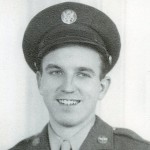
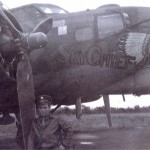 A number of years ago, I requested my dad, Staff Sergeant Allen Lewis Spencer’s military records from the National Personnel Records Center (NPRC) in Saint Louis, Missouri, only to be told that the records had been destroyed by a fire in 1973. I hadn’t heard about this before, and so really knew nothing about the details, except that I would never be able to find any more records of my dad’s military service during World War II, other than the ones we had, which was comparatively little. I wondered how it could be that the only military records for all those men were stored in one building, with no back up records. I know computers were not used as often, but there were things like microfiche back then. Nevertheless, the records were lost…and the loss felt devastating to me.
A number of years ago, I requested my dad, Staff Sergeant Allen Lewis Spencer’s military records from the National Personnel Records Center (NPRC) in Saint Louis, Missouri, only to be told that the records had been destroyed by a fire in 1973. I hadn’t heard about this before, and so really knew nothing about the details, except that I would never be able to find any more records of my dad’s military service during World War II, other than the ones we had, which was comparatively little. I wondered how it could be that the only military records for all those men were stored in one building, with no back up records. I know computers were not used as often, but there were things like microfiche back then. Nevertheless, the records were lost…and the loss felt devastating to me.
When I heard about the fire that destroyed my dad’s records, it all seemed like the distant past, but in reality, it was during my high school years. Then, it just seemed like a bad dream…a nightmare really. I couldn’t believe that there was no way to get copies of those records. My dad’s pictures, one of which was signed by the pilot of Dad’s B-17, on which Dad was a top turret gunner. Those pictures and the few records are all we have of his war years, and to this day, that makes me sad.
The fire broke out on July 13, 1973 and quickly engulfed the top floor of the National Personnel Records Center (NPRC). In less 15 minutes from the time the fire was reported, the first firefighters arrived at the sixth floor of the building, only to be forced to retreat as their masks began to melt on their faces. The fire was that hot!! There was just no way to successfully save the documents that were stored there. The fire burned out of control for more than 22 hours…even with 42 fire districts attempting to extinguish the flames. It was not until five days later that it was finally completely out. Besides the burning of records, the tremendous heat of the fire warped shelves while water damage caused some surviving documents to carry mold.
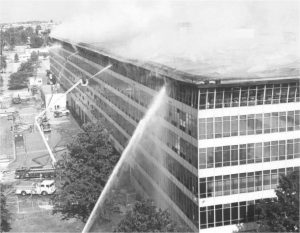
About 73% to 80% of the approximately 22 million individual Official Military Personnel Files stored in the building were destroyed. The records lost were those of former members of the U.S. Army, the Army Air Force, and the Air Force who served between 1912 and 1963. My dad joined the Army Air Force on March 19, 1943 and was discharged October 3, 1945. Many of the documents lost were from those years. They were gone, and there was no way to get them back. The National Personnel Records Center staff continues to work to preserve the damaged records that ere saved. There were about 6.5 million records recovered since the fire.

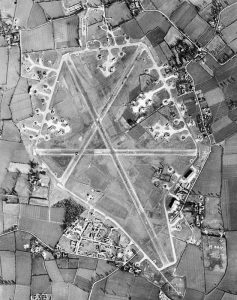 Most of the time, when we think of time and distance here on planet earth, we tend to feel like we are just a speck compared to the size of this planet, and I suppose that is true, but sometimes, our connection to one another is, in reality, much closer than we know. My dad, Allen L “Al” Spencer was a top turret gunner on a B-17G Bomber in World War II. He was stationed at Great Ashfield, Suffolk, England. I have always been very proud of my dad’s service, and because of his service, I have also always had an interest in other World War II bases in England.
Most of the time, when we think of time and distance here on planet earth, we tend to feel like we are just a speck compared to the size of this planet, and I suppose that is true, but sometimes, our connection to one another is, in reality, much closer than we know. My dad, Allen L “Al” Spencer was a top turret gunner on a B-17G Bomber in World War II. He was stationed at Great Ashfield, Suffolk, England. I have always been very proud of my dad’s service, and because of his service, I have also always had an interest in other World War II bases in England.
Yesterday, while researching my husband Bob’s great uncle, Richard F “Frank” Knox for his birthday today, I found myself reading his obituary again, looking for more information on a man I admired. I have always liked Frank very much, but because of the fact that we lived in Wyoming and they lived in Washington, I can’t say that I knew about his everyday life, and I certainly didn’t know about his military career. That said, while I had read the obituary right after his passing July 13, 2017, somehow it didn’t  hit me that he was stationed as a communications officer at RAF Horham, Suffolk, England. Of course, my curious mind had to go to Google Earth. I wanted to know if the Air Base was still visible, because most of them have been in one way or another returned to farm land. I did find the base, and while it’s outline isn’t as clearly marked as Great Ashfield is, I could pick out RAF Horham too. After finding the base, I was able to imagine a young Uncle Frank living and working there during the war. To me, that thought was very interesting, but another thing I noticed was the fact that Horham was not that far from Great Ashfield. In fact, my dad and Bob’s Uncle Frank were stationed a mere 22 miles away from each other. It is doubtful that they ever met, and if they did, they probably wouldn’t remember it, because it would be just in passing, but it occurs to me now, that the two men have probably met in Heaven, and they probably had some interesting stories to tell about their time in England.
hit me that he was stationed as a communications officer at RAF Horham, Suffolk, England. Of course, my curious mind had to go to Google Earth. I wanted to know if the Air Base was still visible, because most of them have been in one way or another returned to farm land. I did find the base, and while it’s outline isn’t as clearly marked as Great Ashfield is, I could pick out RAF Horham too. After finding the base, I was able to imagine a young Uncle Frank living and working there during the war. To me, that thought was very interesting, but another thing I noticed was the fact that Horham was not that far from Great Ashfield. In fact, my dad and Bob’s Uncle Frank were stationed a mere 22 miles away from each other. It is doubtful that they ever met, and if they did, they probably wouldn’t remember it, because it would be just in passing, but it occurs to me now, that the two men have probably met in Heaven, and they probably had some interesting stories to tell about their time in England.
As big as this old world is, and as unlikely as it seems that two families could have some close connections like this, I find that at least in my life, and my husband’s life, there are some connections, some very near misses, and some interesting encounters. Like my dad, Uncle Frank served out his time in the Army Air Forces right there 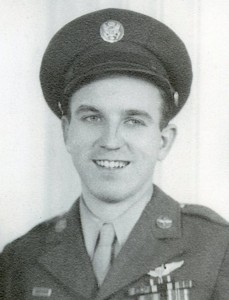
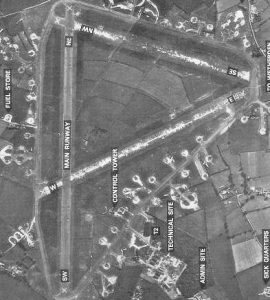 at RAF Horham, Suffolk, England. I imagine that like my dad, Frank took at least one leave to go and see London, because how could you go to England and not see London. Frank had a successful career in communications and then after his discharge from the service, four years, four months and four days of active duty, separating at war’s end with the rank of major. Frank served with distinction, earning a Bronze Star and the Air Medal, then he continued his military career in the Air Force Reserve. He retired in 1968 with the rank of Lieutenant Colonel. Today would have been Uncle Frank’s 98th birthday, and it is his first in Heaven. Happy birthday in Heaven, Uncle Frank. We love and miss you very much.
at RAF Horham, Suffolk, England. I imagine that like my dad, Frank took at least one leave to go and see London, because how could you go to England and not see London. Frank had a successful career in communications and then after his discharge from the service, four years, four months and four days of active duty, separating at war’s end with the rank of major. Frank served with distinction, earning a Bronze Star and the Air Medal, then he continued his military career in the Air Force Reserve. He retired in 1968 with the rank of Lieutenant Colonel. Today would have been Uncle Frank’s 98th birthday, and it is his first in Heaven. Happy birthday in Heaven, Uncle Frank. We love and miss you very much.
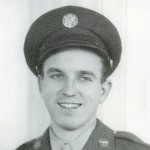
 Most of the time, when I think about the faces from my parents’ past, I think of ancestors, or school friends, or maybe even old flames. All of those people bring questions to mind, but most of them can be answered, and the relationship laid to rest, at least in the case of old friends or old flames, but some faces continue to run through my mind again and again. Such is the case with the men who served in the Army Air Force with my Dad at Great Ashfield Army Air Base, which is just North of Ipswich in Suffolk, England. I know these men were Dad’s good friends, because they were important enough to him to take their pictures to preserve their memory for the rest of his life, but for whatever reason, their names were not put on the pictures, so I don’t know who they were.
Most of the time, when I think about the faces from my parents’ past, I think of ancestors, or school friends, or maybe even old flames. All of those people bring questions to mind, but most of them can be answered, and the relationship laid to rest, at least in the case of old friends or old flames, but some faces continue to run through my mind again and again. Such is the case with the men who served in the Army Air Force with my Dad at Great Ashfield Army Air Base, which is just North of Ipswich in Suffolk, England. I know these men were Dad’s good friends, because they were important enough to him to take their pictures to preserve their memory for the rest of his life, but for whatever reason, their names were not put on the pictures, so I don’t know who they were.
Dad never talked much about the war, something that, while common among people who have fought in such battles, I nevertheless find strange. I always knew that he was a top turret gunner and flight engineer on a B-17 Bomber during World War II, but much of that information came from my mom. I guess she didn’t really know why Dad wouldn’t tell his daughters about something that made her and us so very proud of him either. I guess it just wasn’t his style, or maybe the memories of what he had to do there were just too hard to talk much about. Dad has always been such a gentleman, and had such a gentle spirit, that I’m quite certain that killing, even from a plane with a bomb, and not having to look at the faces of those who died, was something that was hard to live with, even though it was necessary, and even though he felt strongly about the purpose for which he was fighting.
In his letters home to his mom and family, he mentioned some names of friends from home, or people he trained with, but they were so restricted on what they could write about during their time in England, and the people they were with, that few names were mentioned. It was only after Dad had passed away, and we were going through pictures from his past for his slide show, that we found these pictures of his friends from his military days…those faces from Dad’s past, that I wonder about now. It was too late to ask Dad who they were then, and I have always been sorry about that. My niece, Michelle asked him about some of his military days for a report she was doing, but she didn’t know about these 
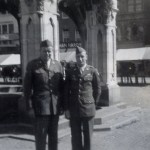 pictures then, or she might have asked.
pictures then, or she might have asked.
I will probably never know who these men were, or if they were members of Dad’s crew on the B-17 he assigned to, and I am sorry about that. I have been trying to find out more about his military days and the men he served with, and these pictures could have been a great source of valuable information. Sadly, I will probably always wonder about the faces from Dad’s past, and the impact they had on his life.

